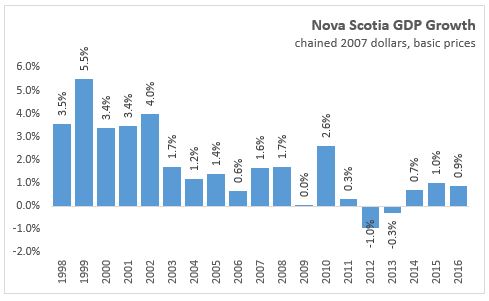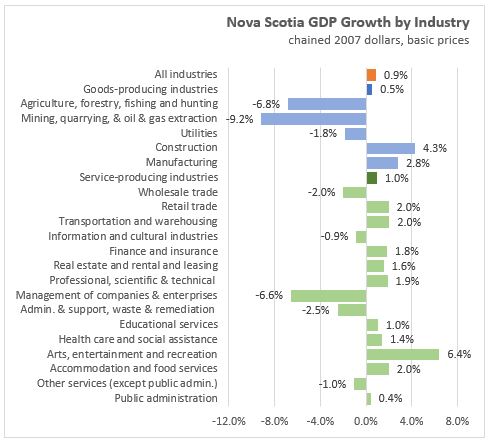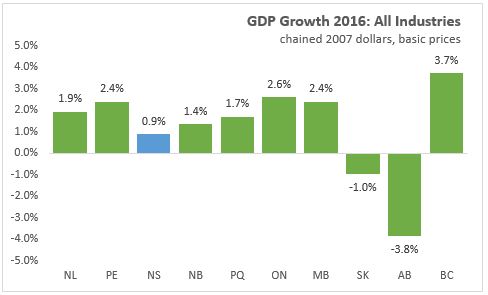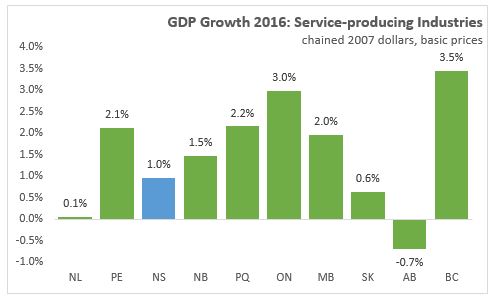The Economics and Statistics Division maintains archives of previous publications for accountability purposes, but makes no updates to keep these documents current with the latest data revisions from Statistics Canada. As a result, information in older documents may not be accurate. Please exercise caution when referring to older documents. For the latest information and historical data, please contact the individual listed to the right.
<--- Return to Archive
For additional information relating to this article, please contact:
May 01, 2017PROVINCIAL GDP BY INDUSTRY 2016 The preliminary estimates of economic growth for the provinces and territories in 2016 were released today by Statistics Canada. This data on the growth of the economy is measured at the industry level with chained 2007 dollars at basic prices (sellers' prices before taxes less subsidies on products) that removes the effect of price changes. In 2016, Nova Scotia real GDP grew 0.9 per cent, following on growth of 1.0 per cent in 2015 and 0.7 per cent in 2014. The goods-producing sector expanded by 0.5 per cent and service-producing industries grew by 1.0 per cent.


The goods-producing sector expansion of 0.5 per cent follows on growth of 0.3 per cent in 2015. In 2016, construction activity expanded 4.3 per cent due to an increase in engineering construction with work on the Maritime Transmission link and development of Touquoy gold mine. Residential construction (+1.6%) increased while non-residential building construction (-11.0%) decreased with the completion of Halifax Shipyard Assembly facilities and near completion of Nova Centre. Manufacturing activity was up 2.8 per cent with increases in shipbuilding, aerospace, sawmills, and seafood products offsetting declines in paper manufacturing, fabricated metal and miscellaneous food manufacturing. Fishing, hunting and trapping activity declined 9.0 per cent due to a late start to lobster season and weather factors. Mining, quarrying and gas extraction declined 9.2 per cent with declines in oil and gas extraction (-2.1%), other non-metallic mineral mining and quarrying (-18.1%) and support activities for oil and gas extraction (-29.1%).
Service-producing industries GDP grew by 1.0 per cent, following on growth of 1.1 per cent in 2015. Wholesale activity declined 2.0 per cent with lower activity in the machinery, equipment and supplies subsector. Retail activity was up 2.0 per cent on gains in motor vehicle and parts dealers and general merchandise stores. Transportation and warehousing activity grew with a 12.2 per cent increased in Air transportation. Real estate and rental and leasing, including imputed rent for owner-occupied dwellings, grew 1.6 per cent. Growth in professional, scientific and technical services was primarily from the growth in computer systems design and related services (+15.8%). Growth also occurred with amusement and recreation (+20.6%), traveller accommodations (+4.5%) and food services and drinking places (+1.1%). Real GDP decline in information and cultural industries, management of companies and enterprises, administrative and support services and other services. Real GDP for educational services (+1.0%), health care and social assistance (+1.4%) and public administration (+0.4%) all increased in 2016.

British Columbia (+3.7%) and Ontario (2.6%) continued for a second year to have the fastest real GDP growth among the provinces. Real GDP declined for a second consecutive year in both Saskatchewan and Alberta. Growth in Newfoundland and Labrador (+1.9%) was largely attributable to increases output in oil and gas extraction. Prince Edward Island (+2.4%) was its strongest pace in a decade due to the construction, manufacturing, and service-producing sectors. New Brunswick growth slowed to 1.4 per cent with closing of Piccadilly potash mine weighing on growth seen in other sectors. Quebec growth was 1.7 per cent, faster than the 1.2 per cent pace in 2015 as there were gains in both private and public service-producing sector. Ontario growth of 2.6 per cent came from growth related to a robust housing market while manufacturing increasing 1.8 per cent in the province. Manitoba goods-producing sector output grew with construction work on electric power generation and transmission projects. Saskatchewan declined 1.0 per cent as residential and engineering construction and mining, quarrying and oil and gas extraction all fell. Alberta's GDP declined 3.8 per cent with the last time GDP declined in two consecutive years being in 1982 and 1983. Alberta goods-producing sector declined 8.6 per cent with declines also in wholesale trade, professional, scientific and technical services, administration and support services, and offices of real estate agents. British Columbia led growth with 3.7 per cent increase as residential construction grew 17.0 per cent and increased housing related services (agents, lessors, banking and insurance).



Note: GDP by Industry data provides an industry-level snapshot of economic activity in different sectors of Nova Scotia's economy. Estimates are provided for 2016 without revisions to previous years. Revised estimates for 2014 to 2016 will be published in November 2017. To view Statistics Canada release click here.
<--- Return to Archive